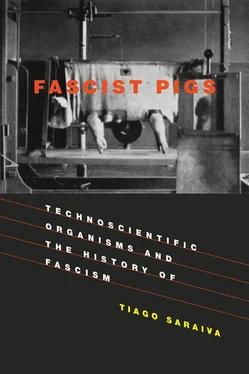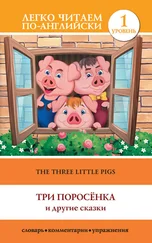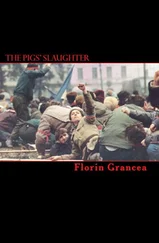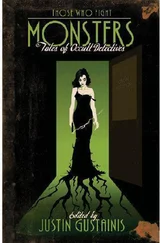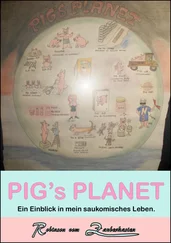And the structure wasn’t directed only at controlling farms; it also included credit cooperatives from which farmers obtained funds to buy their annual stock of seed and fertilizers, the cooperatives and merchants to whom the farmers delivered their produce, and the dairies, mills, and factories that processed food for consumption in the cities. [50]Vertical unions (Hauptvereinigungen) included every individual involved in the production, processing, or sale of one crop (grain, potatoes, sugar, cattle, milk, and so on). These unions regulated production quotas, set grading requirements, and could prevent the creation of new enterprises. The Food Estate reached an enrollment of about 17 million members, which made it the biggest of all the organizations of the Nazi regime. Historians’ common obsession with revealing the many flaws of the RNS has led to repeatedly underestimate its contribution in expanding the infrastructural power and the reach of the Nazi state. [51]It is not just that the RNS was quite successful in increasing production and reducing at the same time food imports, making German agriculture much more self-sufficient than it had been before the Nazis seized power. The point is more about missing the importance of the RNS in institutionalizing Nazism as a regime. It should be hard to dismiss the significance of an organization that exercised more or less direct control over more than 25 percent of Germany’s GDP and constituted the largest economic unit in the world. [52]
How, then, can we reconcile the portrayal of Darré as the radical conservative author of Das Bauerntum als Lebensquell der nordischen Rasse (1929) and Neuadel aus Blut und Boden (1930), two books that contributed to making his name on the extreme right and that would justify his position as one of the chief ideologues of the Nazi Party, with this gigantic bureaucratic arrangement aimed at bringing a new order to the German fields by standardizing farmers’ procedures? If historians insist in offering an image of Darré as no more than a Medieval nostalgic aching for an organic society built on estates (Stände), they should at least incorporate the qualifications introduced in 1940 by a sharp observer of the corporatist phenomenon in Nazi Germany: “There is little that is feudal and much that is anti-feudal in the method of creation, the internal life and the purposes of the 1940 streamlined Stände.” [53]Let us keep that suggestive formulation of the “streamlined Estate” in mind when we explore the relations between the RNS and the BRA—between the Nazi regime and science.
After the Nazis seized power, the seed market, like everything else related to agriculture, would be centrally regulated. A meeting held in December 1933 between RNS officials and BRA scientists was to clarify the respective tasks considering plant protection, the first assuming all responsibilities in economic issues and the latter exclusively scientific ones. [54]In practical terms this meant the transfer of control of the regional network of local Plant Protection Offices from the BRA to the RNS. Such change was also a reaction to repeated criticisms concerning BRA activities by Erwin Baur, a major German geneticist and the first director of the Kaiser Wilhelm Institut für Züchtungsforschung (Kaiser Wilhelm Institute for Plant Breeding), who urged the BRA to make a choice between being a bureaucratic office and being a research institute. Baur argued that the BRA couldn’t have it both ways. [55]Baur had it wrong, for that was just what happened.
Eduard Riehm—the director of the BRA from Otto Appel’s retirement in 1933 till 1945, whose administration thus coincided with the life span of the Nazi regime—reacted to the reproach by invoking Baur’s privileged connections to H. Dietrich, former agriculture minister of the Reich from 1928 to 1930 and member of the left-leaning German Democratic Party (Deutsche Demokratische Partei). Riehm called Baur a “badischen Demokrat” and promised to align the BRA with the new order, well in tune with his membership in the NSDAP. [56]And in truth the idealized neat separation between bureaucratic and scientific spheres in plant protection during the Nazi years was, as we shall see, meaningless. Riehm, in 1936, was the first to assert the major role of his institution at the service of the Battle of Production. [57]
The Seed Decree of March 1934 confirms the importance of seed circulation for the streamlined RNS. The creation of a standardized certifying system and the prevention of selling uncertified seed, overseen by local branches of the RNS, contributed to the varietal cleansing of the market that allegedly was leading to the steep increases in yield demanded by the Battle for Production. In the apparent strict division of economic and scientific tasks between the RNS and the BRA, this regulation of the seed market clearly fell under the jurisdiction of the RNS. Nevertheless, what happened was that the previous Varietal Registry Commission of the BRA in Berlin-Dahlem was simply renamed the Office for Varietal Registration (Sortenregisterstelle) of the RNS, keeping its incumbency of producing the List of Approved Varieties now to be enforced by RNS officers. [58]In addition, these RNS officers were also trained at the BRA in short courses on seed certification. [59]Instead of just spreading the list among the members of the DLG, as had been done before the Nazis seized power, the list was now distributed through the extended network of the RNS. [60]More important, this was not just a service for better informing peasants about the best breeds. RNS officials used it instead to confirm which breeds could be cultivated in the national soil and which breeds could not. Apparently there was no resistance to having part of the RNS bureaucratic structure inside the BRA.
We now have a clearer picture of the entanglements between the work undertaken at the BRA and the institutionalization of the RNS. The control by the latter of the German seed circuit was built on standards developed in the laboratories of the first. Without the sprout test developed by BRA researchers in connection with the research on wart disease, there would have been no biological basis for the RNS’s varietal list. The RNS could undertake seed cleansing as an important part of its Battle for Production thanks to the sprout tests conducted by the BRA.
The fact that a seed decree was issued no more than a year into Nazi rule merits reflection. Comparing it briefly with the American case may illuminate what was at stake. The US Plant Patent Act, issued in 1930, concluded a long-term lobbying effort by nurserymen to have their innovations protected by legal rights. [61]It was passed as a typical Hoover-Republican anti-depression measure, meant to promote innovation by private breeders and thus to save federal money, since until then public institutions did the large majority of breeding work. The patent act applied only to plants reproduced asexually by budding, by grafting, by the rooting of clippings, or by the dividing of bulbs. It was considered that only in these cases was it possible to guarantee the genetic identity of progeny, and that a patent would be meaningless for plants reproduced sexually by pollination and seeds. The Plant Patent Act thus protected innovation first and foremost in fruit and nut trees, vinous fruits (grapes, strawberries, and blueberries), but also in ornamental shrubs, vines, and perennials such as lilacs, peonies, and roses. Quite tellingly, two of the most important plants in the seed market—wheat and corn—were excluded. For these, instead of a commercial patent, a seed certification system had been in place since 1919, with state agencies publishing lists of recommended varieties. [62]Seed dealers were certified by local experiment stations, guaranteeing that seed was genetically pure and that it would grow uniformly and with good germinability. In 1939 the Federal Seed Act was passed to protect farmers from buying unreliable seed and to safeguard “quality seeds from the competition of less worthy alternatives—and thus [protect] the intellectual property investment that produced the quality.” [63]
Читать дальше
